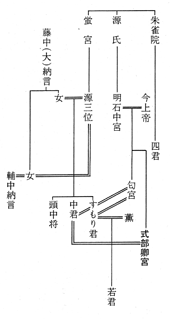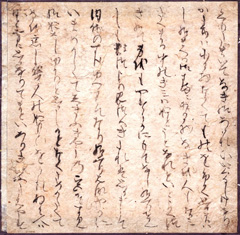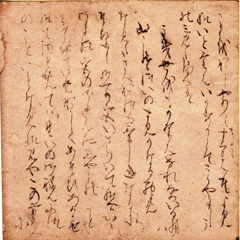Top>Research>There were more than 54 scrolls to the Tale of the Genji - fragments of an ancient manuscript of the lost Sumori chapter discovered -
 Index
Index

Kazuomi Ikeda [Profile]
Education course
There were more than 54 scrolls to the Tale of the Genji
- fragments of an ancient manuscript of the lost Sumori chapter discovered-
Kazuomi Ikeda
Professor of Classical Japanese Literature, Faculty of Letters, Chuo University
Tales rewritten and recopied
At the start of the Edo Period, the technology of wood-block printing was used for the first time to undertake the mass printing of literary works and produce what are now known as block-printed books. However, before the Edo Period, literary works were widely read in the form of manuscript copies. If you wanted to read a tale or an anthology of Japanese poetry, the only choice was to borrow the book from some another person and copy the manuscript by hand.
In order to copy the sacred teachings accurately and without any mistakes, copies of Buddhist scriptures and other works relating to religion and faith were produced by copying every character and phrase exactly as it was to be found in the original. The same was true for Chinese poetry, kanbun (classical Chinese writings produced by Japanese writers) and Japanese poetry, genres which were regarded as legitimate literature. However, tales and stories were works of entertainment that comforted the hearts of women and children, and therefore were not regarded as legitimate literary works. In the Heian Period, both the tales and the authors had a low position in society. It is only very recently that being an author has come to be seen as an enviable profession as in modern times and that literary works have come to be protected by copyright laws.
Tales enjoyed low social esteem, and the people of the Heian Period did not consider it necessary to respect the original version of the story or to copy it accurately. In Makura no Soshi (The Pillow Book; section 262 of the Noin-bon), Sei Shonagon wrote that "when a story is poorly copied, it is a shame for everyone, including the author." The original manuscripts of tales were indeed sometimes callously rewritten to the extent that the author was to be pitied. Not only the language of the tales but even the plots of the stories themselves were modified. According to Mumyo Zoshi, a critique of tales which was written in the early Kamakura Period, there already existed in that time an original version and a modified version of the tales entitled Torikaebaya monogatari (The Changelings). Even in the case of the famous Tales of Ise, it is believed that the version established by Fujiwara Teika consisting of 125 sections only came into being after a long period of modification and growth, in other words by augmentation and revision by later writers.
The existence of chapters other than the original 54 that make up the Tale of Genji
Now, let's consider the case of the Tale of Genji. It is commonly thought that no such modifications were made to the sacred classic that is the Tale of Genji. However, in reality, even the Tale of Genji was not immune to such changes. The Shiro-Zoshi, which was written at the end of the Heian Period, lists the titles of 3 chapters that were added to the other 54 by later writers. These three chapters are Sakura-Hito (Cherry Blossom Person), Samu-Shiro (Small Rush Mat) and the Sumori (Nest of Protection). Again, Genjishaku (Commentaries on the Genji), which was the first commentary on the Tale of Genji and was written at the end of the Heian Period, cites. 13 passages from Sakura-Hito and comments upon them. By the end of the Heian Period, not only had there been modifications made to the language of the Tale of Genji, but also Sakura-Hito, Sumori, and other chapters had been added to the original manuscript. These kinds of changes took place during the approximately 200 years between the creation of the original manuscript in the middle of the Heian Period and the Aobyoshibon (Blue Cover Book) edition which was produced by Fujiwara Teika in the early Kamakura Period. The Tale of Genji only became a fixed and sacred text after Fujiwara Shunzei and Fujiwara Teika made the tale the subject of academic study as a text for those composing Japanese poetry.
Restoration of the old text of the Sumori chapter

Chart showing the relationships between the characters in Sumori
The Sakura-Hito and Sumori chapters were read as part of the Tale of Genji from the end of the Heian Period until the Kamakura Period. Unfortunately, manuscript copies of these chapters have not survived to the present day. Chapters bearing the titles Sakura-Hito and Sumori are contained within the 6 chapters of Kumogakure (Hiding in Clouds), which survives in a copy made in the Muromachi Period but these are different works from the Sakura-Hito and Sumori that existed at the end of the Heian Period. In order to distinguish between the different versions, the lost version of the Sumori chapter is referred to as the "old text of Sumori."
Fortunately, some evidence relating to the ancient Sumori scroll has survived and to a certain extent it is possible to reconstruct the human relationships of the characters and the plot of the Sumori chapter using materials that date back to the Kamakura Period. These materials include the Genji monogatari kokeizu (Tale of Genji Ancient Genealogy),which includes family lineages and abbreviated explanations to facilitate easy understanding of the Tale of Genji, a work in which many different characters appear, and the Genji monogatari wakashu (Collection of Japanese Poems from the Tale of Genji), which contains only Japanese poems from the Tale of Genji and which includes several poems written by characters who appear in the Sumori chapter). The human relationships and plots which can be surmised from these materials are listed below.
One son and two daughters (Tonochujo, Sumorinosanmi, Nakanokimi) were born to Genzanmi, the child of Hotaru Hyobukyonomiya. Nakanokimi, the younger sister, served Onnaichinomiya, the daughter of the Emperor, and had relationships with Nioumiya. Eventually, through the guidance of Tonochujo, Nioumiya also had relations with Sumorinosanmi, the older daughter, who also came to serve Onnaichinomiya. Eventually, Shikibukyonomiya, the older brother of Nioumiya, also came to have relations with Nakanokimi. Nakanokimi succeeded her nursemaid to become Naishinosuke (a lady in waiting). Sumorinosanmi disliked the flamboyant personality of Nioumiya. Sumorinosanmi was moved by the deep sincerity of Kaoru-Gimi and the two fell in love, with Sumorinosanmi giving birth to a child. However, after these events, Nioumiya continued to hover around Sumorinosanmi. Sumorinosanmi disliked Nioumiya's advances and hid herself on Mt. Ouchi, which was inhabited by Onnashinomiya (the wife of Reizeiin who had left the household after falling out of favour with her husband). Sumorinosanmi then spent the rest of her days performing religious devotions.
The relationships between Nioumiya, Sumorinosanmi, and Kaoru in the Sumori chapter are the reverse of the relationships between Kaoru, Ukifune, and Nioumiya in the current version of the Tale of Genji. In the current version of the Tale of Genji, Ukifune is stolen from the serious and noble Kaoru by the amorous and erotic Prince Nioumiya. It can be inferred, then, that a later copyist sympathized with Kaoru and wrote the Sumori chapter with Kaoru victorious in the game of love as an addition to the story.
The discovery of fragments of the old Sumori text
Here are two fragments containing part of a tale. The calligraphy of ancient manuscripts from the Heian Period and the Kamakura Period is very beautiful, so the pages were often cut out and made into hanging scrolls to be used as decorative pieces for the tea ceremony and other events. These two pieces were cut out for precisely that purpose. Usually, fragments of tales made into hanging scrolls are taken from the Tale of Genji, the Tales of Ise, or the Tale of Sagoromo. However, these two pieces are not from such tales, nor are they from any other tales which currently exist. It is thought that they are portions of a lost tale. When compared with the Venus de Milo, for example, the discovery of these two pieces would not be equivalent to the discovery of the lost arms, for example, but rather to the discovery of a lost finger or a lost fingernail. What tale were these two pieces taken from?

The first piece contains words such as "Nakanokimi," "Senji," "Naishinosuke" and "Shikibukyonomiya," which are exactly the same as characters that appear in the old Sumori text. The phrase "a beautiful and profound-looking woman crying sorrowfully" is thought to refer to Sumorikimi. The phrase "Senji" is used in association with "Nakanokimi," and this seems connected to the fact that the Genji monogatari kokeizu (Tale of Genji Ancient Genealogy) refers to Nakanokimi as "Senji." Also, Nakanokimi was given the position of "Naishinosuke" by some person, and this matches the explanation that "Nakanokimi succeeded her nursemaid and became Naishinosuke" as the Genji monogatari kokeizu (a work held at the Research Institute of Japanese Literature at Tsurumi University) puts it.
The fragment also contains the following passage: "Nakanokimi was a flamboyant and modern person, and began relations with Shikibukyonomiya. In earlier times, she had relations with a brother of Shikibukyonomiya, and could not forget the time she spent with him. However, he had become infatuated with a new woman." This also matches a passage in the Genji monogatari kokeizu which states: "Nioumiya, who had been involved with Nakanokimi, began to have relations with the older sister Sumorikimi. Shikibukyonomiya, the older brother of Nioumiya, began to have relations with Nakanokimi."

The second fragment is thought to be from the scene at Mt. Ouchi. The person reading the 10 scrolls which seem to be sutras is Shinomiya, and it is most likely Sumorikimi who is jealously watching and crying. It contains phrases such as "drawing close and bending down" and "Miya comes out, still unfinished", so it seems that someone is sleeping with Sumorikimi unbeknownst to Shinomiya. That person may be Kaoru, and the relationship between Kaoru and Sumorikimi may have continued after she went into hiding at Mt. Ouchi. The emotion of the woman is expressed as "if I turn my back on the world and leave my household, then this mountain will become my final hideaway, the same as the moon." These emotiosn, along with the devotion to Buddhism, matche the account of Sumorikimi given in the Genji monogatari kokeizu.
As described above, the two pieces match precisely with the supposed contents of the old Sumori text as reconstructed indirectly from extant materials. It is likely that the pieces are fragments of a manuscript copy of the missing Sumori chapter.
The Sumori chapter was read as a portion of the Tale of Genji from the end of the Heian Period until the Kamakura Period but was then lost. A portion of that chapter has been discovered in these two pieces. This is a small but significant discovery.
Radiocarbon dating
The two pieces have been subjected to advanced scientific analysis for age dating by measuring the amount of radiocarbon contained in their paper. As a result of the age dating, the pieces have been shown to date from sometime between the end of the Kamakura Period and the Nanbokutyo period (1288 to 1304, or 1367 to 1384). These pieces are therefore evidence of the existence of a Sumori chapter manuscript that was written between the end of the Kamakura Period and the Nanbokutyo period. They are also evidence that a version of the Tale of Genji that contained more than the original 54 scrolls was read even during this period. I very much hope that other pages taken from the same manuscript will be discovered in the future.
- Kazuomi Ikeda
Professor of Classical Japanese Literature, Faculty of Letters, Chuo University - Born in 1950 in the Shinjuku Ward of Tokyo. Holds a Doctorate of Literature from the University of Tokyo). Left the Doctoral Program at the University of Tokyo Graduate School of Humanities in 1978. Also in 1978, he assumed the position of Full-Time Instructor at Ibaraki University College of Humanities, later serving as an Assistant Professor. In 1993, assumed the position of Professor at the Chuo University Faculty of Letters.
His field of expertise is Classical Japanese Literature. In particular, his research focuses on the expression and methods of the Tale of Genji, as well as on literary materials (kohitsugire, or paper fragments from ancient manuscripts). Also holds an interest in the history of calligraphy and writing, holding positions such as Visiting Instructor at the Heian Calligraphy Association (Calligraphy Culture Center). His major written works include The Tale of Genji: Expressive Structure and Undercurrents (Musashinoshoin) and The Tale of Genji Read as a Lover's Tryst (ASCII Media Works).
- Research Activities as a Member of Research Fellowship for Young Scientists (DC1), Japan Society for the Promotion of Science (JSPS) Shuma Tsurumi
- Important Factors for Innovation in Payment Services Nobuhiko Sugiura
- Beyond the Concepts of Fellow Citizens and Foreigners— To Achieve SDGs Goal 10 “Reduce Inequality Within and Among Countries” Rika Lee
- Diary of Struggles in Cambodia Fumie Fukuoka
- How Can We Measure Learning Ability?
—Analysis of a Competency Self-Assessment Questionnaire— Yu Saito / Yoko Neha - The Making of the Movie Kirakira Megane








